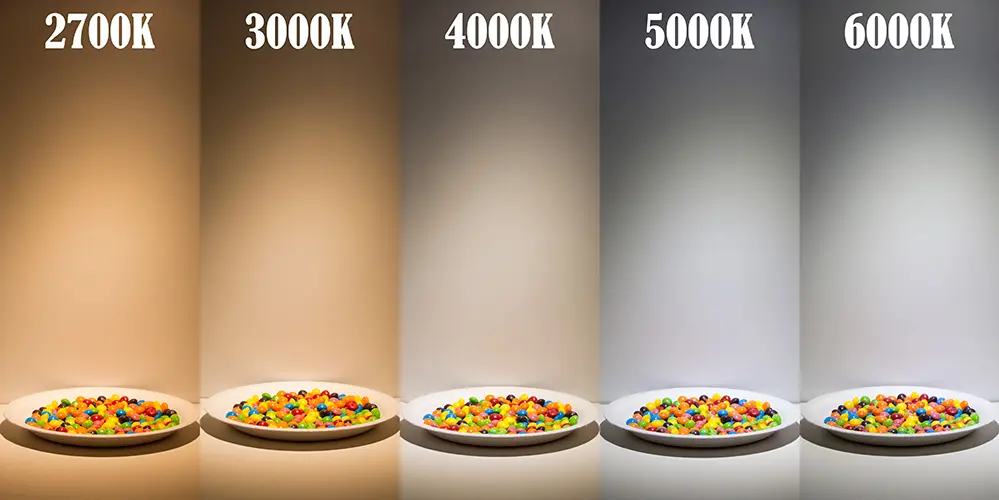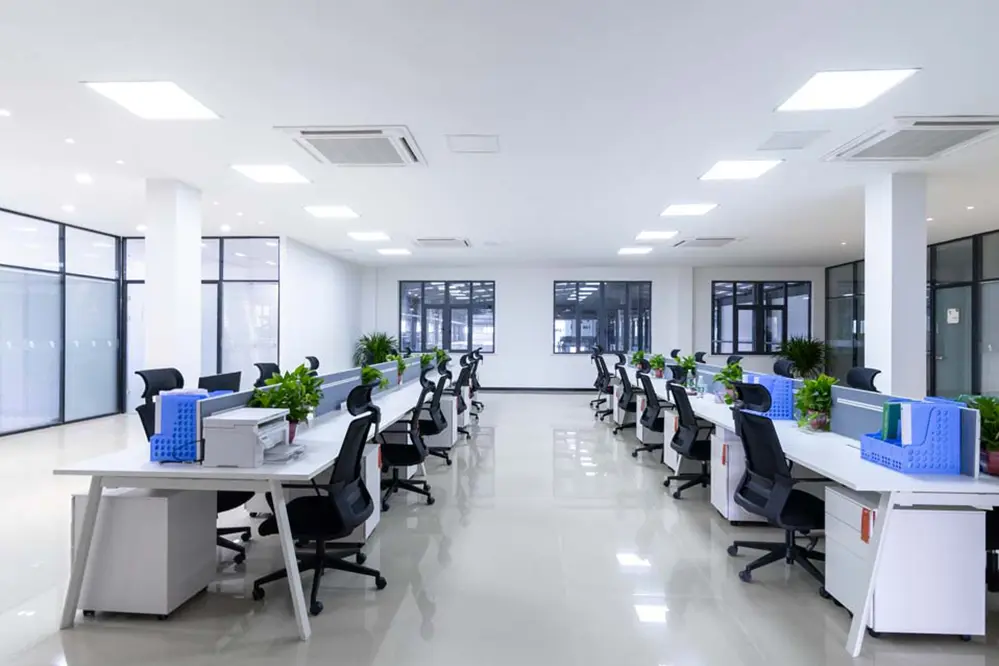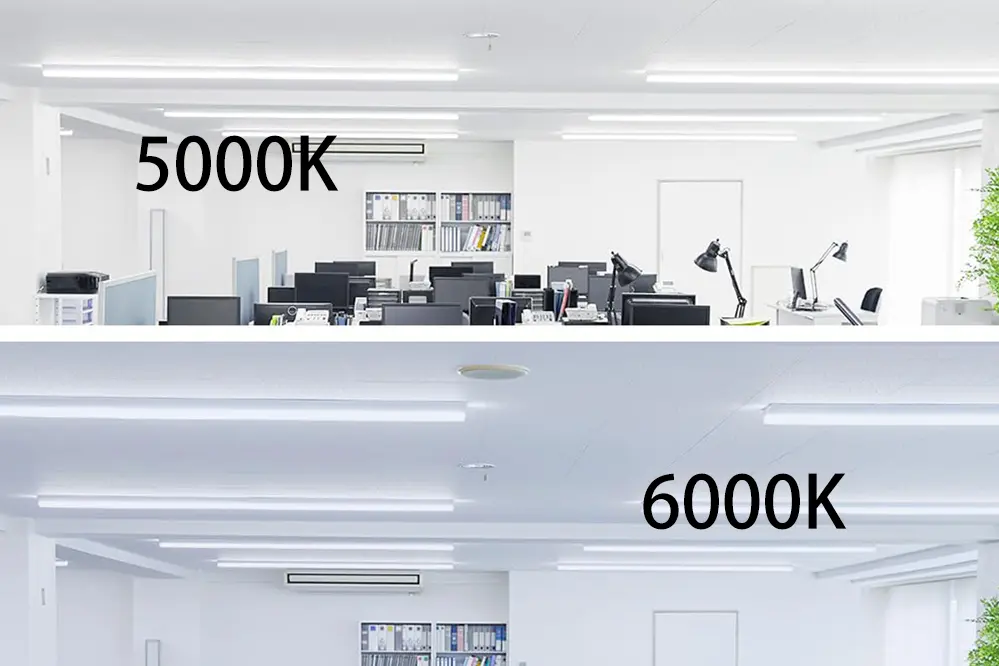Are you a lighting enthusiast or professional seeking to illuminate your space with the perfect LED lighting? Look no further! In this blog post, we will unravel the mysteries surrounding the contrasting color temperatures of 5000K and 6000K LEDs. Get ready to embark on a journey of discovery as we delve into the world of bright white versus daylight white illumination.
When it comes to LED lighting, color temperature plays a crucial role in creating the desired ambiance. But what exactly do we mean by 5000K and 6000K? Well, let’s break it down. 5000K LEDs emit a bright white light that closely resembles natural daylight, providing a crisp and vibrant illumination. On the other hand, 6000K LEDs take it a step further, offering a cooler and more intense daylight white light. The distinction may seem subtle, but it can make a world of difference in setting the right mood for your space.
Now, let me introduce myself. I’m Tom, and I’ve been an integral part of the LED lighting industry since 2005. With years of experience and a deep understanding of LED technology, I’ve developed this blog post to share my expertise and help you make informed decisions when it comes to choosing the perfect LED lighting for your needs. From unraveling technical jargon to providing practical tips, I’ve got you covered.
So, are you ready to dive right in? Join me as we explore the nuances between 5000K and 6000K LEDs, uncover the benefits and drawbacks of each, and discover which one suits your specific requirements. Whether you’re an avid lighting enthusiast or a seasoned professional, this blog post will equip you with the knowledge you need to make the right lighting choices. Let’s embark on this illuminating journey together!
Decoding Color Temperatures in LEDs

The subtleties of color temperatures in LEDs are akin to selecting the right shade of paint to capture the exact mood an artist envisions. This is particularly true when comparing 5000K and 6000K LEDs, which differ in the quality and psychological impact of the light they emit. Nestled within the higher spectrum of white light, these temperatures influence the perceived sharpness and clarity present within a given space, effectively altering the visual narrative.
Graduations in Kelvin values are critical in creating spaces that resonate emotionally with occupants. The choice between 5000K, often termed as ‘bright white,’ and 6000K, referred to as ‘daylight,’ makes a definitive statement about the ambiance. Precisely, it shifts the psychological overtones of an environment from warm and inviting to a vigilant and focused atmosphere.
The Science of Kelvin Measurements
Kelvin is the unit of measure for color temperature, indicating the hue and tone of white light emitted by a source.
White light is not uniform; subtle Kelvin shifts can foster different emotions, crafting an ambiance unique to each setting.
At 5000K, LEDs emit a bright, clean white light, ideal for tasks requiring visual acuity and concentration, such as office settings.
6000K LEDs produce a more daylight-like white, conducive to environments where natural light replication and alertness are desired.
Impact of Color Temperatures on Perception
Color temperature profoundly influences human perception within illuminated environments. The Kelvin scale serves as a pivotal determinant in visual and psychological responses. With Kelvin ratings like 5000K and 6000K, LEDs have the power to shape emotional atmospheres and influence cognitive functions.
Leveraging 5000K, which embodies a crisp white hue, can evoke a sense of purity and efficiency, conducive for task-oriented spaces. Conversely, the cooler 6000K spectrum, approximating natural daylight, can invigorate and heighten alertness, mimicking the energizing effect of early morning light.
Illumination at 6000K can also potentially disrupt circadian rhythms if used extensively after sundown, as it mimics the blue-enriched light of a clear sky. It’s pivotal to deploy such temperature settings judiciously, maintaining an equilibrium that aligns with our natural biological clock.
Artful application of LEDs in the 5000K to 6000K range can enhance spatial esthetics, accentuating textures and colors with clarity. It enhances visual comfort and can guide the intended use of spaces, whether for concentration in professional settings or active engagement in commercial environments.
Distinct choices in color temperature facilitate a tailored experience, setting the scene for the intended interaction with space. This can range from the immersive focus of a 5000K workspace to the vitality of a 6000K retail setting.
Exploring the 5000K LED Spectrum

The 5000K color temperature of LEDs stands in the realm often termed as “bright white,” and it bridges the visual gap between warm and cool lighting atmospheres. Offering a balanced white light, this LED spectrum is instrumental in environments where precision and attention to detail are paramount. It provides a clear, crisp light that is conducive to task performance without tending toward the cooler, bluer end of the spectrum.
Such lighting is optimal for spaces requiring a neutral setting, where the objective is to simulate midday light. It offers an excellent color rendition, making it ideal for settings like offices or kitchens where both efficiency and color accuracy are crucial.
Characteristics of 5000K Lighting
The 5000K LED emits a bright, white light, balancing clarity with an approach that doesn’t strain the eyes. It is less stark in appearance when compared to higher color temperatures and promotes an environment of productivity and alertness.
In essence, a space illuminated by 5000K lighting provides a visual experience akin to natural daylight around midday. This equidistant position between warm and cool tones results in a lit environment that enhances color perception without biasing the color spectrum. Such uniform lighting is highly sought in environments that necessitate a high level of detail and color accuracy, such as in art studios or design workshops.
Furthermore, 5000K lighting avoids casting shadows that can obscure details or create an unevenly lit workspace. Its consistent output facilitates the identification of fine details, making it an ideal choice for intricate tasks in scientific laboratories, assembly lines, or meticulous inspection areas.
To summarily encapsulate, 5000K lighting is considered quintessential for tasks that require a high level of precision without a sacrifice of comfort. Its balanced white light produces minimal glare and replicates a neutral and stable environment akin to natural daylight, which is paramount in technical workplaces, high-end retail, and even certain residential settings. By providing an effective simulation of natural light conditions, 5000K lighting can enhance visual performance and reduce eye fatigue, bridging the gap between functionality and comfort with finesse.
Best Uses for 5000K Illumination
5000K LED lighting offers a balanced white light best used in settings that require clarity without harshness.
- Precision Tasks: Enhances visual acuity for detailed work in environments like laboratories and technical workplaces.
- Artistic Spaces: Maintains true color perception in art studios, photography, and design spaces.
- Commercial Retail: Offers a neutral light that accurately represents merchandise colors in high-end retail.
- Healthcare Facilities: Assists medical staff in diagnosis and treatment areas by providing clear, bright light.
- Outdoor Spaces: Ideal for security lighting, as it mimics daylight, enhancing visibility without being overpowering.
In these applications, 5000K LEDs support activities where color differentiation and detailed focus are critical.
The controlled brightness of 5000K avoids overstimulation, keeping environments comfortable and reducing eye strain.
The Distinct Quality of 6000K LEDs

The 6000K LED light spectrum emits a cool, crisp hue, akin to natural daylight with an invigorating intensity. In essence, the illuminative characteristics of 6000K light sources are equidistant from the vibrancy of daylight and the sterility of industrial lighting, making them uniquely versatile. They create an ambiance where attention to detail and high-contrast clarity are paramount, especially in professional or creative settings.
Defining Features of 6000K Light
6000K LEDs emit a light that closely resembles daylight at midday, with a crisp and vibrant feel.
Ideal for task-oriented environments, these LEDs offer a high color temperature, simulating the midday sun’s natural vigor. Enhanced clarity and sharpness make this light particularly useful for intricate tasks.
At 6000K, the light veers towards a bluish-white shade, creating an effect of sharp precision, often favored in design studios and technical workspaces.
The intense and sharp quality of 6000K light is unparalleled for high-detail applications, where discernment between subtle hues is necessary.
It is the cooler, more stimulating end of the white light spectrum, invigorating spaces with its daylight-like quality.
Ideal Applications for 6000K LEDs
6000K LEDs bring forth a quality of light well-suited for scenarios demanding acute visual acuity and concentration.
- Precision Workstations: Environments such as engineering or architectural drafting rooms.
- Commercial Retail Spaces: Showcasing products, jewelry, or apparel under the most likened-to-natural illumination.
- Art Studios: Providing artists with a true-to-daylight context for color matching and detailing.
- Medical Facilities: Assisting staff with tasks requiring clear, bright light, such as in dental offices or surgical rooms.
- Automotive Detailing: Illuminating fine details in vehicles during cleaning or repair services.
Their incisive intensity supports environments where clear, direct light benefits productivity and craftsmanship.
In settings where color accuracy and sharp detailing are crucial, 6000K LEDs prevail, offering a light spectrum that mimics the zenith of daylight.
5000K vs 6000K: Making the Right Choice
When deliberating between 5000K and 6000K LEDs, it is paramount to consider the nuances of your lighting application. A 5000K luminary, with its bright but slightly warmer glow, often provides a balanced ambience that is conducive to multipurpose settings, where comfort and clarity are both required. This color temperature strikes a balance, rendering colors with fidelity without lending the austere sharpness sometimes associated with its cooler counterpart, the 6000K.
On the other hand, 6000K LEDs are distinguished by a stark, daylight mimicry, which is optimal in arenas where the finest details must not escape the eye. Their unparalleled brightness and higher degree of bluish tint cater to situations demanding utmost concentration and precise color discernment, often preferred in high-stakes environments where the emulation of outdoor lighting conditions is indispensable.
Comparing Color and Brightness
The color temperature of LED lighting is a critical factor in setting the intended ambiance and functionality of a space.
- 5000K LEDs – Designated as ‘bright white’, these units emit a clean and vibrant light that closely resembles midday sunshine, without leaning too heavily into the cooler spectrum.
- 6000K LEDs – Also known as ‘daylight white’, they offer a more intense and cooler light compared to 5000K, with a distinctive blueish tint, equivalent to a cloudless noon.
- Color Rendering Index (CRI) – While not inherently tied to color temperature, higher CRI values (closer to 100) alongside these temperatures ensure that colors appear more accurately and vividly.
5000K LEDs are ideal for creating an inviting yet brilliantly illuminated environment.
6000K LEDs, on the other hand, excel in areas requiring crisp and sharp lighting that simulates the feel of natural daylight.
Suitability for Different Environments
5000K LEDs provide a balance that is perfect for residential and office settings. Their light quality is stimulating yet not harsh, fostering environments where focus and clarity are needed without creating an overly sterile atmosphere.
For industrial and commercial spaces, the piercing brightness of 6000K LEDs is beneficial. This cooler, more vivid light offers superior visibility, making it ideal for high-precision tasks. It is particularly useful in areas where attention to detail is critical, such as assembly lines, laboratories, or art studios.
Conversely, 5000K LEDs excel in educational environments where comfort is key. The balanced white light supports a variety of activities from reading to hands-on experiments, promoting concentration without the fatigue associated with bluer, more intense light spectrums.
Lastly, when considering outdoor lighting, 6000K LEDs are often chosen for their resemblance to daylight. This makes them suitable for parking lots, sports fields, and other public areas. They provide a sense of security and clear visibility, an essential aspect for spaces meant to be used during evening hours. However, it’s paramount to balance the need for visibility with the responsible use of lighting to prevent light pollution and its impact on the natural environment.
FAQs
Is 5000K too white?
5000K refers to the color temperature of a light source. It falls within the category of cool white light. Whether it is considered “too white” depends on the specific application and personal preference.
In lighting, color temperature is measured in Kelvin (K) and represents the color appearance of the light emitted by a source. Lower color temperatures, such as 2700K, tend to have a warm, yellowish appearance, while higher color temperatures, like 5000K, have a cooler, bluish-white appearance.
5000K is often used in commercial and industrial settings where a bright, crisp, and clean light is desired. It can enhance visibility and provide a more energizing atmosphere. However, in certain residential or cozy environments, some people may find 5000K too harsh or clinical. In these cases, a lower color temperature, like 3000K, might be preferred for a warmer and more inviting ambiance.
It’s important to note that color temperature preference is subjective, and there is no definitive answer to whether 5000K is too white. It ultimately depends on the desired effect, the space’s purpose, and individual preferences.
Is 6000K LED too bright?
A 6000K LED can be perceived as quite bright, as it has a higher color temperature that produces cooler, bluish-white light. This makes it suitable for applications where bright and crisp lighting is desired, such as commercial spaces, task lighting, or outdoor areas. However, the perceived brightness can also depend on factors like the luminous flux or intensity of the LED, as well as the environment in which it is installed.
It’s important to consider the specific lighting needs and preferences for the space in question. Some individuals may find 6000K lighting to be too harsh, especially in residential or more intimate settings, where a warmer color temperature (like 3000K or 4000K) may be more desirable. Lighting design professionals often consider factors such as personal comfort, color rendering, and the intended purpose of the space when selecting the appropriate LED color temperature.
Additionally, it’s worth mentioning that the perceived brightness can also be influenced by the brightness or contrast of surrounding lighting sources, the reflective surfaces in the space, and individual sensitivity to light. So, while a 6000K LED can provide ample brightness for specific applications, it’s important to consider the overall lighting design and the specific needs of the environment in order to achieve optimal lighting conditions.
What is the difference between 5000K and 6500K LED lights?
- Color Temperature: 5000K LED lights have a warm white color temperature, while 6500K LED lights have a cool white color temperature.
- Light Appearance: 5000K LED lights emit a soft white light, similar to incandescent bulbs, while 6500K LED lights produce a bluish-white light that is similar to natural daylight.
- Usage: 5000K LED lights are commonly used for residential lighting, offices, and retail spaces, where a warm and cozy atmosphere is desired. 6500K LED lights are often used in settings where a bright and energizing light is needed, such as hospitals, warehouses, and outdoor areas.
- Melatonin Suppression: The bluish-white light of 6500K LED lights can have a greater impact on melatonin suppression, which may affect sleep patterns. It is recommended to use warmer light in the evening to promote better sleep.
- Color Rendering: 5000K LED lights generally have better color rendering properties, allowing objects and colors to appear more natural. However, both 5000K and 6500K LED lights can have high color rendering indexes (CRI) depending on the specific product.
- Applications: 5000K LED lights are suitable for illuminating living areas, bedrooms, and dining rooms, providing a cozy and inviting ambiance. 6500K LED lights are ideal for task lighting in areas like kitchens, garages, and study spaces, where clarity and focus are essential.
- Daylight Simulation: 6500K LED lights closely replicate the color temperature of natural daylight, making them suitable for use in photography and areas where accurate color representation is important.
- Mood Enhancement: 5000K LED lights can create a warm and relaxing atmosphere, making them popular for use in restaurants, hotels, and leisure areas. 6500K LED lights, on the other hand, can promote alertness and improve productivity in workplaces.
- Energy Efficiency: Both 5000K and 6500K LED lights are energy-efficient, consuming less power compared to traditional incandescent bulbs, resulting in cost savings and reduced environmental impact.
- Personal Preference: The choice between 5000K and 6500K LED lights ultimately comes down to personal preference and the desired ambiance for a specific space. It’s recommended to consider the function, location, and desired lighting effect when selecting between the two.
Are there any brightess difference for 5000K and 6000K LEDs?
When it comes to the brightness of 5000K and 6000K LEDs, it’s important to note that color temperature does not directly correlate with brightness. Both 5000K and 6000K LEDs can have varying levels of brightness depending on factors such as the wattage, lumens, and the specific LED technology used.
The primary difference between 5000K and 6000K LEDs lies in their color appearance rather than their brightness. 5000K LEDs emit a bright white light that closely resembles natural daylight, providing a crisp and vibrant illumination. On the other hand, 6000K LEDs offer a cooler and more intense daylight white light.
It’s worth mentioning that the perception of brightness can also be influenced by personal preferences and the specific application of the lighting. Some individuals may perceive 6000K LEDs as appearing brighter due to their cooler color temperature, while others may prefer the slightly warmer tone of 5000K LEDs.
Ultimately, when selecting between 5000K and 6000K LEDs, it’s essential to consider factors such as the desired ambiance, the specific lighting requirements of your space, and personal preferences. By understanding the differences between these color temperatures, you can make an informed decision that best suits your needs.
How does the light from 5000K and 6000K LEDs affect human circadian rhythms?
Both spectrums can influence circadian rhythms, but 6000K LEDs, mimicking daylight, can have a greater impact on sleep patterns.
Is 5000K or 6000K better for garage?
Which one saves more energy? 5000K LEDs or 6000K LEDs?
When it comes to energy efficiency, both 5000K and 6000K LEDs can offer significant energy savings compared to traditional lighting options. However, the specific energy-saving capabilities of each color temperature can vary depending on various factors.
In general, LED technology itself is known for its energy efficiency. LEDs consume less energy while providing the same or even better illumination compared to traditional lighting sources. This means that regardless of whether you choose 5000K or 6000K LEDs, you can expect to save energy and reduce your electricity consumption.
That being said, the energy-saving potential of LEDs is not solely determined by their color temperature. Other factors such as the wattage, lumens, and efficiency of the specific LED model play a crucial role in determining energy efficiency.
To ensure maximum energy savings, it is recommended to look for LED products that are labeled as energy-efficient or have high efficacy ratings. These LEDs are designed to provide optimal performance while minimizing energy consumption.
Additionally, it’s important to consider the specific lighting requirements of your space. By properly assessing the lighting needs and using lighting controls such as dimmers or timers, you can further optimize energy usage and reduce unnecessary lighting.
In conclusion, both 5000K and 6000K LEDs have the potential to save energy compared to traditional lighting options. To maximize energy efficiency, it is advisable to choose LED products with high efficacy ratings and implement smart lighting practices tailored to your specific needs.
What exactly are 5000K LEDs used for in lighting design?
5000K LEDs emit a bright white light that closely resembles natural daylight, ideal for workspaces and educational settings.
Are 5000K LEDs suitable for outdoor security lighting?
5000K LEDs are appropriate for outdoor use, offering a balance between visibility and reducing harsh glare.
Can 6000K LED lighting be too intense for indoor environments?
Yes, 6000K LEDs, with their daylight white illumination, may be too stimulating for residential interiors, potentially causing discomfort.
Conclusion
In summary, 5000K LEDs provide a neutral, bright white light, suitable for various settings demanding clarity and focus.
While 6000K LEDs impart an intense daylight white glow, beneficial where maximum brightness is paramount, they may not be suitable for all applications.
Crucially, the selection between 5000K and 6000K LEDs hinges on the specific requirements of the environment they are intended to illuminate.
Understanding the nuances in color temperature is vital for lighting professionals, ensuring the right choice for functionality, comfort, and aesthetic preference.
Ultimately, the decision between 5000K and 6000K LEDs rests on the intended use and desired ambiance of the space they will light.
In your quest for the perfect LED lighting solution, it’s essential to partner with a trusted and reliable manufacturer. If you’re looking for top-quality LED Lighting Strips and LED Neon Flex products, look no further than Unitop. As a professional manufacturer based in China, Unitop has a proven track record of delivering high-performance LED lighting solutions to customers worldwide. With their expertise and commitment to quality, Unitop can provide you with the perfect LED products to meet your specific needs. Don’t hesitate to reach out to Unitop today and take your lighting experience to the next level.





